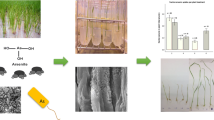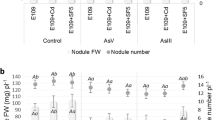Abstract
Reduction in crop yield and contamination of food crops are major problems in many areas due to high soil arsenic content. In this study an aquaglyceroporin (AqpS) disrupted Sinorhizobium meliloti smk956 strain was found to accumulate 70.5% more arsenic than its parental strain S. meliloti Rm1021 under free living condition. This strain was inoculated onto alfalfa host plants under different arsenic concentrations (0, 1 and 5 mg/L) and its ability to alleviate arsenic toxicity in the host plant was investigated. At 1 and 5 mg/L arsenic concentrations the average arsenic contents in the shoots of the plants inoculated with the strain S. meliloti smk956 were 45.5 and 27.5% less than those of the plants inoculated with S. meliloti Rm1021, respectively. Under arsenic stress conditions the strain S. meliloti smk956 showed increased symbiotic efficiency than its parental strain. These results demonstrate a novel method to alleviate arsenic toxicity in alfalfa plants.





Similar content being viewed by others
References
Ahmed FR, Killham K, Alexander I (2006) Influences of arbuscular mycorhizal fungus Glomus mosseae on growth and nutrition of lentil irrigated with arsenic contaminated water. Plant Soil 258:33–41
Arnon DI (1949) Copper enzymes in isolated chloroplasts. Polyphenyloxidase in Beta vulgaris. Plant Physiol 24:1–15
Bardin S, Dan S, Osteras M, Finan TM (1996) A phosphate transport system is required for symbiotic nitrogen fixation by Rhizobium meliloti. J Bacteriol 178:4540–4547
Beers RF Jr, Sizer IW (1952) A spectrophotometric method for measuring the breakdown of hydrogen peroxide by catalase. J Biol Chem 195:133–140
Carrasco JA, Armario P, Pajuelo E, Burgos A, Caviedes AM, López R, Chamber AM, Palomares AJ (2005) Isolation and characterization of symbiotically effective Rhizobium resistant to arsenic and heavy metals after the toxic spill at the Aznalcóllar pyrite mine. Soil Biol Biochem 37:1131–1140
Cooper JE (2007) Early interactions between legumes and rhizobia: disclosing complexity in a molecular dialogue. J Appl Microbiol 103:355–1365
Dong Y, Zhu YG, Smith A, Wang CB (2008) Arbuscular mycorrhiza enhanced arsenic resistance of both white clover (Trifolium repens Linn.) and Rye grass (Lolium perenne L.) plants in arsenic-contaminated soil. Environ Pollut 155:174–181
Eckardt NA (2006) The role of flavonoids in root nodule development and auxin transport in Medicago sativa. Plant Cell 18:1539–1540
El-Deeb SM, Al-Sheri FS (2005) Role of some chemical componunds on the detoxification of Rhizobium leguminosarum biovar vicia by some heavy metals. Pak J of Biol Sci 8(12):1693–1698
Engelke TH, Jagadish MN, Pühler A (1987) Biochemical and genetical analysis of Rhizobium meliloti mutants defective in C4–dicarboxylate transport. J Gen Microbiol 33:3019–3029
Foyer CH, Halliwell B (1976) The presence of glutathione and glutathione reductase in chloroplasts; a proposed role in ascorbic acid metabolism. Planta 133:21–25
Gupta DK, Tripathy RD, Mishra S, Srivastava S, Dwivedi S, Rai UN, Yand XE, Huanki H, Inouhe M (2008) Arsenic accumulation in root and shoot vis-a-vis its effects on growth and level of phytochelatins in seedlings of Cicer arietinum L. J Environ Biol 29(3):281–286
Hartley-Whitaker J, Ainsworth A, Meharg AA (2001) Copper and arsenate induced oxidative stress in Holcus lanatus L. clones with different sensitivity. Plant Cell Environ 24:713–722
Jones FT (2007) A broad view of arsenic. Poultry Sci 86:2–14
Khanuja SPS, Kumar S (1989) Symbiotic and galactose utilization properties of phage RMP64 resistant mutants affecting three complementation groups in Rhizobium meliloti. J Genet 68:93–108
Lindner RC (1944) Rapid analytical methods for some of the more common inorganic constituents of the plant tissues. Plant Physiol 19:76–89
Lowry OH, Rosenbough NZ, Farr AL, Randall RJ (1951) Protein measurements with Folin phenol reagent. J Biol Chem 193:265–275
Marklund S, Marklund G (1974) Involvement of superoxide anion radical in the auto oxidation of pyrogallol and a convenient assay for superoxide dismutase. Eur J Biochem 47:469–474
Mascher R, Lipmann B, Holzinger S, Bergmann H (2002) Arsenate toxicity: effects on oxidative stress response molecules and enzymes in red clover plants. Plant Sci 163:961–969
Meharg AA, Hartley-Whitaker J (2002) Arsenic uptake and metabolism in resistant and non-resistant plant species. New Phytol 157:25–31
Park S (2006) Study of an enzyme activity in extracts of Ginkgo biloba leaves. Bull Korean Chem Soc 27:1185–1187
Prasad CK, Vineetha KE, Hassani R, Gupta R, Randhawa GS (2000) Isolation and symbiotic characterization of aromatic amino acid auxotrophs of Sinorhizobium meliloti. Ind J Exp Biol 38:1041–1049
Reichman SM (2007) The potential use of the legume-rhizobium symbiosis for the remediation of arsenic contaminated sites. Soil Biol Biochem 39:2587–2593
Sadasivan S, Manickam A (1996) Nitrogen Fixation. In: Biochemical methods. New Age International (P.) Ltd. New Delhi, India, pp. 213–219
Singh HP, Batish DR, Kohli RK, Arora K (2007) Arsenic-induced root growth inhibition in mung bean (Phaseolus aureus Roxb.) is due to oxidative stress resulting from enhanced lipid peroxidation. Plant Growth Regul 53:65–73
Sriprang R, Hayashi M, Yamashita M, Ono H, Saeki, Murooka Y (2002) A novel bioremediation system for heavy metals using the symbiosis between leguminous plant and genetically engineered rhizobia. J Biotechnol 13:279–293
Stoeva N, Berova M, Zlatev Z (2005) Effect of arsenic on some physiological parameters in bean plants. Biol Plant 49:293–296
Takahashi Y, Minamikawa R, Hattori KH, Kurishima K, Kihou N, Yuita K (2004) Arsenic behavior in paddy fields during the cycle of flooded and non-flooded periods. Environ Sci Technol 38:1038–1044
Yang HC, Cheng J, Finan TM, Rosen BP (2005) Novel pathway for arsenic detoxification in the legume symbiont Sinorhizobium meliloti. J Bacteriol 187:6991–6997
Zahran HZ (1999) Rhizobium-legume symbiosis and nitrogen fixation under severe conditions and in arid climate. Microbiol Mol Biol Rev 63(4):968–989
Zhengwei Z, Fang W, Lee HY, Yang Z (2005) Responses of Azorhizobium caulinodans to cadmium stress. FEMS Microbiol Ecol 54:455–461
Acknowledgements
The authors sincerely thank Dr. T.M Finan and Dr. S.Long for providing the strains. We also thank University Grants Commission, India for providing fund for the research.
Author information
Authors and Affiliations
Corresponding author
Additional information
Responsible Editor: Juan Barcelo.
Rights and permissions
About this article
Cite this article
Panigrahi, D.P., Randhawa, G.S. A novel method to alleviate arsenic toxicity in alfalfa plants using a deletion mutant strain of Sinorhizobium meliloti . Plant Soil 336, 459–467 (2010). https://doi.org/10.1007/s11104-010-0496-x
Received:
Accepted:
Published:
Issue Date:
DOI: https://doi.org/10.1007/s11104-010-0496-x




